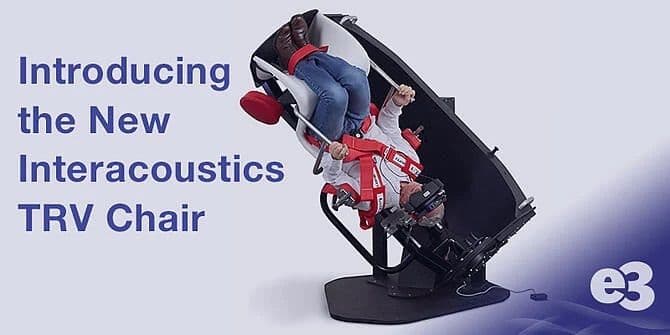Introducing the New Interacoustics TRV Chair

If you’re familiar with Interacoustics’ line of vestibular testing equipment, then you know that they are always pushing the boundaries and breaking new ground in the realm of balance assessment technology. Recently, they added to their long list of technological achievements with the release of the TRV chair, a new tool for diagnosis and treatment of benign paroxysmal positional vertigo (BPPV).
The difference between the TRV chair and other vestibular diagnostic chair products is that it gives you the ability to rotate the patient 360 degrees across the plane of each semicircular canal. Also, you’re able to lock the patient in place in any position for a more detailed look at each semicircular canal. For a visual demonstration of how this works, watch the video below.
Why the TRV is Important for BPPV Treatment
BPPV is the most common cause of otogenic vertigo. Unfortunately, traditional positional testing can be difficult with some patient groups, including those who are heavy, elderly, disabled, and those who have neck issues. That’s what makes the TRV so useful in testing for BPPV. Because it can rotate in a 360-degree range so smoothly, you can test and treat these types of patients without having to worry about causing them discomfort or putting any unnecessary strain on yourself. The patient is secured by a four-point harness, a leg strap, shoulder pads and a head mount. Eye movements are displayed on-screen using the VisualEyes™ Video Frenzel system.
Increase the Success Rate of Your BPPV Treatment Kinetic Energy
The rehabilitation of patients with BPPV involves maneuvers such as the Epley and Semont maneuvers. By adding kinetic energy to these maneuvers, the TRV chair can cure the dizzy patient. To transmit kinetic energy, the main arm of the TRV chair is driven against a hydraulic stop. This produces a mild deceleration, which relocates even the smallest otoconia, thereby securing a successful treatment.
Kinetic energy accelerates the movement of free-floating calcium-carbonate crystals, also known as otoconia. Dizziness or vertigo are often symptoms of wrongly located otoconia within the inner ear. Thus, kinetic energy is often the only feasible treatment for patients with canalithiasis who experience positioning-related nystagmus due to wrongly located otoconia.
Learn More About the TRV Chair Today!
For more information on the Interacoustics TRV chair and the benefits it brings to BPPV testing and treatment, get in touch with your local e3 office today!
Find Local Office
